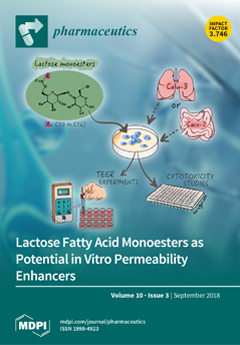Open AccessArticle
Development and Evaluation of a Reconstitutable Dry Suspension to Improve the Dissolution and Oral Absorption of Poorly Water-Soluble Celecoxib
by
Hye-In Kim 1,2,†, Sang Yeob Park 3,†, Seok Ju Park 4, Jewon Lee 5, Kwan Hyung Cho 6, Jun-Pil Jee 7, Hee-Cheol Kim 2, Han-Joo Maeng 8,* and Dong-Jin Jang 1,2,*
1
Department of Pharmaceutical Engineering, Inje University, Gimhae 50834, Korea
2
Institute of Digital Anti-Aging Healthcare, Inje University, Gimhae 50834, Korea
3
Samyang Biopharmaceuticals Corporation, Seongnam 13488, Korea
4
Division of Nephrology, School of Medicine, Inje University, Busan 47392, Korea
5
Department of Nano Science and Engineering, Inje University, Gimhae 50834, Korea
6
Department of Pharmacy, College of Pharmacy, Inje University, Gimhae 50834, Korea
7
Department of Pharmacy, College of Pharmacy, Chosun University, Gwangju 61452, Korea
8
College of Pharmacy, Gachon University, Incheon 21936, Korea
†
These authors are equally contributed to this work.
Cited by 17 | Viewed by 7283
Abstract
This study aims at developing and evaluating reconstitutable dry suspension (RDS) improved for dissolution rate, oral absorption, and convenience of use of poorly water-soluble celecoxib (CXB). Micro-sized CXB particle was used to manufacture nanosuspension by using bead milling and then RDS was made
[...] Read more.
This study aims at developing and evaluating reconstitutable dry suspension (RDS) improved for dissolution rate, oral absorption, and convenience of use of poorly water-soluble celecoxib (CXB). Micro-sized CXB particle was used to manufacture nanosuspension by using bead milling and then RDS was made by spray-drying the nanosuspension with effective resuspension agent, dextrin. The redispersibility, morphology, particle size, crystallinity, stability, dissolution, and pharmacokinetic profile of the RDS were evaluated. RDS was effectively reconstituted into nanoparticles in 775.8 ± 11.6 nm. It was confirmed that CXB particles are reduced into needle-shape ones in size after the bead-milling process, and the description of CXB was the same in the reconstituted suspension. Through the CXB crystallinity study using differential scanning calorimetry (DSC) and XRD analysis, it was identified that CXB has the CXB active pharmaceutical ingredient (API)’s original crystallinity after the bead milling and spray-drying process. In vitro dissolution of RDS was higher than that of CXB powder (93% versus 28% dissolution at 30 min). Furthermore, RDS formulation resulted in 5.7 and 6.3-fold higher area under the curve (AUC
∞) and peak concentration (
Cmax) of CXB compared to after oral administration of CXB powder in rats. Collectively, our results suggest that the RDS may be a potential oral dosage formulation for CXB to improve its bioavailability and patient compliance.
Full article
►▼
Show Figures






